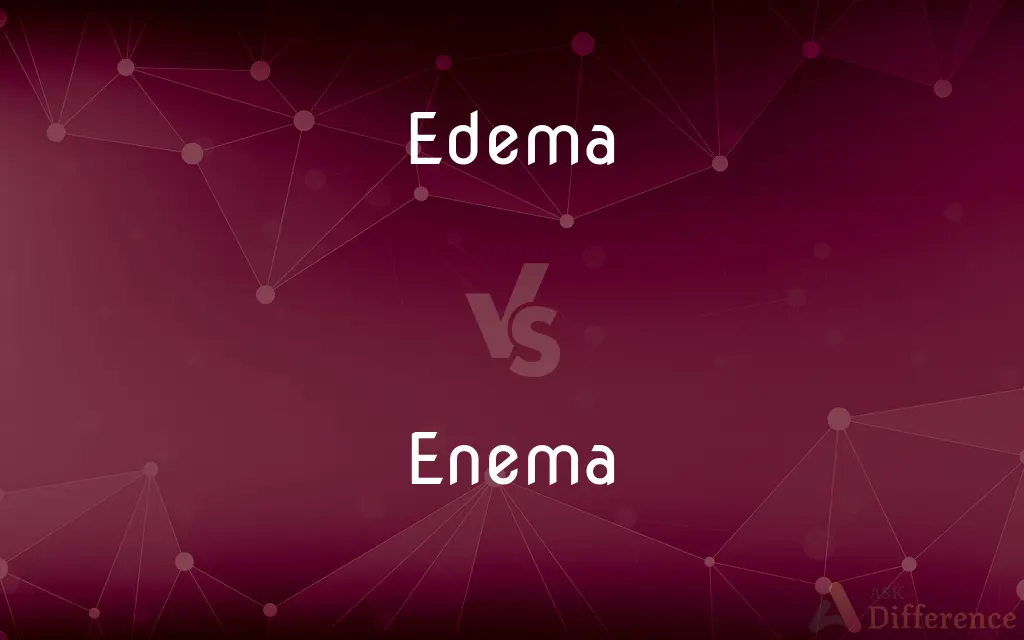Edema vs. Enema — What's the Difference?
By Maham Liaqat & Fiza Rafique — Updated on March 1, 2024
Edema is the medical term for swelling caused by excess fluid trapped in the body's tissues, often seen in feet and legs. An enema is a procedure involving the introduction of liquid into the rectum to stimulate bowel movement or for diagnostic purposes.

Difference Between Edema and Enema
Table of Contents
ADVERTISEMENT
Key Differences
Edema is a condition characterized by an abnormal accumulation of fluid beneath the skin or in one or more cavities of the body, leading to swelling. It can result from various causes, including heart failure, kidney disease, liver cirrhosis, or direct damage to the veins, such as deep vein thrombosis. An enema, on the other hand, is a method used to cleanse or stimulate the bowel, involving the injection of a liquid solution into the rectum through the anus.
Edema can affect any part of the body, though it's most commonly observed in the hands, arms, feet, ankles, and legs. Enemas are used for a variety of purposes, including relieving constipation, administering medication or anesthesia, and preparing the bowel for medical examinations like colonoscopies.
Symptoms of edema include swelling, stretched or shiny skin, and skin that retains a dimple after being pressed. The solution introduced during an enema can vary, including water, soap solutions, or specific medications, depending on the intended purpose.
Edema involves the passive accumulation of fluid in tissues leading to swelling, an enema is an active procedure aimed at cleansing or medicating the lower bowel. Edema is a symptom or manifestation of an underlying condition, whereas an enema is a medical intervention or treatment method. Understanding the distinction between these two terms is important for recognizing the difference between a health condition and a therapeutic procedure.
Comparison Chart
Definition
Swelling caused by excess fluid in body tissues.
Procedure to introduce liquid into the rectum.
ADVERTISEMENT
Nature
Medical condition or symptom.
Medical procedure or treatment.
Primary Causes
Heart failure, kidney disease, liver cirrhosis, vein damage.
Constipation, bowel preparation for diagnostic tests.
Common Locations
Hands, arms, feet, ankles, legs.
Rectum and lower bowel.
Symptoms/Outcomes
Swelling, stretched skin, skin dimpling.
Bowel movement stimulation, bowel cleansing.
Purpose
Indicates an underlying health issue.
Relieves constipation, prepares for medical tests, delivers medication.
Treatment/Management
Addressing the underlying cause, compression, diuretics.
Introduction of solutions like water, soap, or medication.
Compare with Definitions
Edema
Often results from heart or kidney problems.
His edema was a complication of heart failure.
Enema
Can be used for medical preparation.
An enema was required to prepare for the surgical procedure.
Edema
Managed by treating the underlying cause.
Diuretics were prescribed to manage her edema.
Enema
Involves introducing liquid into the rectum.
She was given a saline enema before the colonoscopy.
Edema
Abnormal fluid accumulation in tissues.
After standing all day, she noticed edema in her ankles.
Enema
May deliver medication directly to the colon.
A medicated enema was used to treat his inflammation.
Edema
Can cause swelling and discomfort.
Edema in her legs made it difficult to wear shoes.
Enema
A procedure to cleanse the lower bowel.
The doctor recommended an enema to relieve constipation.
Edema
Edema, also spelled oedema, and also known as fluid retention, dropsy, hydropsy and swelling, is the build-up of fluid in the body's tissue. Most commonly, the legs or arms are affected.
Enema
Aims to stimulate bowel movements.
The enema effectively relieved her bowel discomfort.
Edema
May require lifestyle changes.
She reduced salt intake to help control her edema.
Edema
(Medicine)An excessive accumulation of serous fluid in tissue spaces or a body cavity.
Edema
(Botany)A condition of plants characterized by blisterlike swellings on the leaves or other parts, caused by an accumulation of water.
Edema
An excessive accumulation of serum in tissue spaces or a body cavity.
Edema
A similar swelling in plants caused by excessive accumulation of water.
Edema
Swelling from excessive accumulation of serous fluid in tissue
Common Curiosities
Can edema go away on its own?
Mild edema, especially if caused by factors like standing for long periods, often resolves with rest and elevation. Persistent edema requires medical evaluation.
How often can you safely use an enema?
Frequent use of enemas can lead to dependence and disrupt natural bowel function. It's important to follow medical advice on their use.
Can edema be dangerous?
Yes, edema can be a sign of serious health conditions, especially when it involves the lungs (pulmonary edema) or is severe and widespread.
Are there different types of enemas?
Yes, there are several types, including cleansing, retention, medicated, and barium enemas, each with specific purposes.
Are enemas safe?
When performed correctly, enemas are generally safe but should be done under medical advice to avoid potential risks like bowel tears or electrolyte imbalances.
Can edema affect any part of the body?
Yes, while it's most common in the legs and arms, edema can affect any part of the body, including the face, abdomen, and lungs.
What are the signs that an enema is working?
A successful enema leads to a bowel movement, often within minutes to an hour after administration, indicating that the lower bowel has been emptied.
Can both edema and enemas indicate health issues?
Edema is a symptom of underlying health conditions, while enemas are a treatment tool that can also be used for diagnostic purposes, indicating potential concerns in bowel function or preparation for investigative procedures.
Is it possible to perform an enema at home?
Yes, enemas can be performed at home using over-the-counter kits, but it's important to follow instructions carefully and consult a healthcare provider when necessary.
Can lifestyle changes affect edema?
Yes, reducing salt intake, exercising, and elevating the affected limbs can help manage edema.
Share Your Discovery

Previous Comparison
Episode vs. Spell
Next Comparison
Light vs. LighterAuthor Spotlight
Written by
Maham LiaqatCo-written by
Fiza RafiqueFiza Rafique is a skilled content writer at AskDifference.com, where she meticulously refines and enhances written pieces. Drawing from her vast editorial expertise, Fiza ensures clarity, accuracy, and precision in every article. Passionate about language, she continually seeks to elevate the quality of content for readers worldwide.















































